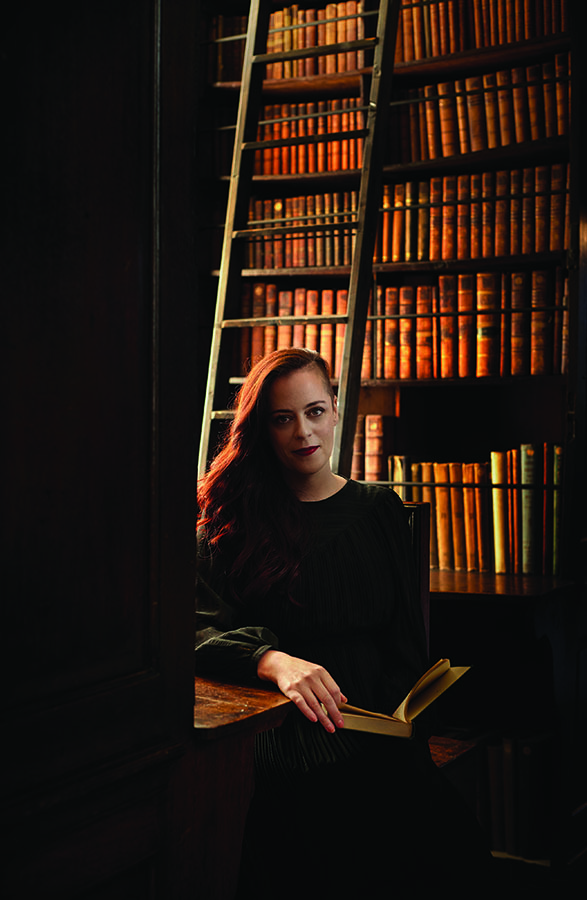I grew up on Cnoc na Naomh surrounded by the northwest boglands of the Donegal Gaeltacht. It was a place that encouraged me to think imaginatively about history, roots and culture. My grandmother, Mary Thaidhg, who also lived on the hill, instilled in me a great belief in oral storytelling and folklore. She was full of piseoga, leigheasanna and tall tales about her years as a domestic servant in New York. Mary taught me that language is a portal and that Gaeilge, the tongue we spoke at home, offers a uniquely rich perspective on the world. Through Mary’s scéalaíocht I developed an ear for the musicality of words and a curiosity about how that songfulness might translate onto the page. Unsurprisingly, I went on to discover poetry and I fell in love with the work of the sage Biddy Jenkinson who writes that “the poet is by profession a troublemaker. She must be independent to the point of eccentricity and is often, though not necessarily, as curst as a crow-trodden hen and as odd as one of the triple-faced monsters with which the Celts depicted Ogma the omniscient, gazing in all directions at once.”

In my debut poetry collection, Bloodroot, (Doire Press, 2017), I first began to tinker with personal history by peeling back the layers on family ancestry. The title poem references the story of a family member who was sent to the Castlepollard Mother and Baby Home in the 1950s and who became parted from her firstborn child for almost forty years. In my follow-up collection, The Poison Glen, (The Gallery Press, 2021), I revisited the theme of family separation, this time with a lens on the ‘missing’ child and looking to the left behind sites of former church and state industrial or ‘reform’ schools and other ‘care’ institutions.
Some poems draw directly from my girlhood experience of being raised in a family that fostered children. Altramas (the Gaeilge word for fosterage) is a concept deeply embedded into ancient Irish culture but today the practice looks very different. One of my poems remembers the day a teenager came to the family home to say a last goodbye to the baby she was about to relinquish to adoption. The first mother; the ‘ghostgirl’. It was an encounter that shifted my whole understanding of what it means to come of age in a patriarchal society.
Poetry is discovery and poems revolve out of my subconscious the way dreams revolve, slowly and over time. In the same way that speaking a dream aloud seems to alter the dream, the act of writing is, by nature, transformative. In my role as UCD/Arts Council Writer in Residence 2025, I’ve had the gift of designated time to evolve a series of new projects and to consider certain relevant questions: Cad is brí le stair fholaithe nó doiléir a scríobh? Cad iad na dúshláin? Cad iad na freagrachtaí? What does it mean to write hidden or obscured histories? What are the challenges? What are the responsibilities? These questions have been greatly nourished by the time spent with university students, staff and alumni through a series of public workshops titled Poet as Troublemaker. Through these tailored poetry workshops I’ve encouraged participants to think of themselves as witness to family stories, social histories, and the living culture of folklore, magic and the Otherworld. Together we’ve opened up conversations about the place of witnessing in Irish literature, and looked at the history of the Irish filidh. We’ve untangled the difficulties of writing trauma, hurt and social injustice, and embraced the possibilities of working with native rituals and ceremonies passed to us ó ghlúin go glúin.
When I began my residency term in January, I was given a spacious writing desk and a large, clear window in the Newman Building that overlooks the leafy campus. Amazed I was to watch the trees come into full bloom. Still, I am often to be found in the dark corners of the UCD National Folklore Collection, buried in the treasure trove of their books, handwritten manuscripts, audio recordings, videos and photographs, drawings and paintings. The National Folklore Collection is one of the largest collections of folklore material in the world and the mere, papery smell of the rooms never fails to thrill me. Truly, I could not have dreamed of a better location to develop my latest poetry collection ‘A Hymn to All the Restless Girls’ (due in November 2025 with The Gallery Press). These poems celebrate the girl who appears to be an outsider – the rebel, the truth speaker and the one who is, often, necessarily a troublemaker. She is the kind of girl who is always questioning and searching. In some poems she takes the figure of Mary Thaidhg, in others she is recognisable as public figures from Irish history or mythology. The book’s title is inspired by A Restless Life, the autobiography of the late poet and novelist Leland Bardwell, and many of these poems in this third collection are carefully hand-stitched with folklore, Gaeilge words and the atmosphere of rural living. The book features a long poem titled ‘Raven lore for a Restless Girl‘, which weaves together elements of ‘fiachaireacht’ (the art of watching the ravens for omens) with snippets of material pulled from cabinets of the National Folklore Collection.
Like most poets, I am often working on several projects at once. In addition to the delivery of workshops, poetry readings and one-to-one mentoring, I am developing a new opera libretto titled The Curing Line for Straymaker, a new company led by Irish composer Michael Gallen. Tá an ceoldráma bunaithe ar ár dtaighde leanúnach ar thraidisiúin dhúchasacha na hÉireann maidir le “leigheasanna a dhéanamh”. Leanann sé téamaí an leighis, an bháis, agus an tobchliste comhshaoil, trí scéal a phléann, agus muid ag smaoineamh gur rudaí éagsúla iad beatha an duine agus an timpeallacht, go bhfuil ag teip ar an tsochaí a admháil go bhfuil bunchodanna dínn féin agus dár gcultúr ag dul in éag.
Mar chuid den obair seo, bhain mé taitneamh as daoine a chur faoi agallamh; daoine a bhfuil leigheasanna teaghlaigh faighte acu le haghaidh tinnis ar nós fuiliú, asma, faithní agus craosghalar srl. B’aistear thar a bheith suimiúil é agus tríd an tionscadal seo chuaigh mé i muinín mo chreideamh i dtraidisiún rúndiamhair agus muirneach. Arna choimisiúnú ag Centre Culturel Irlandais Paris, tá an ceoldráma léirithe ag Straymaker i gcomhar le Féile Ealaíon Chill Chainnigh, Miroirs Étendus, Once Off Productions agus Féile Ceoldrámaíochta Chóbanhávan. Tá Duais Fedora, an duais cheoldráma is mó ar domhan, buaite ag The Curing Line cheana féin, agus beidh sé ar stáitse den chéad uair ag Féile Ealaíne Chill Chainnigh i mí Lúnasa 2026 sula dtéann sé ar camchuairt in Éirinn agus go hidirnáisiúnta sa bhiaiste in 2026/27.
The UCD/Arts Council residency has offered me a year to ground my practice in what I love to do. Is aoibhinn liom ceardaíocht agus rúndiamhair na filíochta. Is breá liom an t-idirphlé a eascraíonn as comhoibriú cruthaitheach. Is breá liom an ‘immram’ nó an turas isteach go dtí an Saol Eile agus a bheith le filí atá ag teacht chun cinn ar an gcéad aistear i dtreo an leathanaigh. I have benefited hugely from the exposure at UCD to world-class scholarship, expertise and research. Last spring I was lucky enough to take several of the UCD Earth Institute campus walks where among other things I learned about ‘Hanami’, the Japanese traditional custom dedicated to admiring the blooms of cherry trees. What a gift it has been to write on a campus full of wildflowers and in the presence of lakes, ducks, swans; to be thinking and dreaming alongside a diverse community. As a child I watched my father cut turf and work on fishing trawlers as my mother’s knitting circle made Aran jumpers to order. Making was a way of being in relationship and, contrary to what many believe, even poetry does not get made in isolation. It has been extraordinarily energising to be here, in this environment, where making in collective spaces is embodied and valued. I love being here with the ordinary ritual of making a poem from scratch; of being with that lovely labour of wrestling with an image, a sentence, a word. Poetry is a way of sitting with uncertainty. Bíonn tú i gcónaí ag dul sa tseans. Caithfidh tú tosú sa dorchadas gan aon rud a bheith ar eolas agat agus ligean duit féin a bheith saor.
■ Annemarie Ní Churreáin is the UCD/Arts Council Writer in Residence. She is the current poetry editor at The Stinging Fly Magazine. Visit studiotwentyfive.com
A Hymn to All the Restless Girls
On this anniversary of The Irish State better instead to celebrate a restless girl.
A restless girl speaks the language of a birch.
A restless girl can besmirch a priest in a flash.
A restless girl takes a splash of whiskey before noon.
The skin of a restless girl smells of gunfire and wolves.
Often a restless girl will ask if not now, when?
Many restless girls fall asleep in the sun.
One restless girl had to be pinned down by six men.
Another restless girl tore up an image of the pope.
A restless girl may disguise herself as a stone.
Sometimes a pale horse will take a restless girl away in the night.
The underslip of a restless girl should not be washed; it should be burned.
When leaving a room first check the corpse of a restless girl has not sprung alive behind your back.
Best always to bury a restless girl in the wettest, darkest earth.
It has been said that a restless girl once returned to haunt an innocent man.
A whole town can be fouled by one restless girl.
But see how the restless girl shimmers in the razor-light of a Scots pine.
See how she sweetens the air like hawthorn.
The restless girl belongs to us as fox belongs to moon.
The fact is the restless girl has been, for us, a constitution.
On public occasions we wear a necklace from which the ornament of her cut tongue hangs.
If the last restless girl ends up drowned, or turned to ash, or trapped inside a horse-haired wall, what then?
What then?
